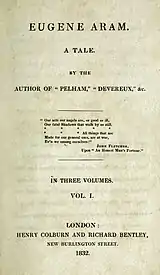Eugene Aram (novel)
Eugene Aram is a melodramatic novel by the British writer Edward Bulwer-Lytton first published in 1832. It depicts the events leading up to the execution of Eugene Aram in 1759 for murdering his business partner.[1]

Adaptations
Lytton started the novel after having completed the first act of a play on the same subject, then dropping it in favour of what he considered the higher art form. This first act was then extended into a five-act play, giving proper credit to Lytton, by New Orleans poet Espy William Henricks Williams (30 January 1852 – 28 August 1908), and published 1873, shortly after publication by W. G. Wills of The Fate of Eugene Aram,[2] which has been performed (as Eugene Aram) in England and Australia.[3]
The novel was adapted three times for silent films, in 1914,[4] 1915[5] and 1924.[6]
References
- Bulwer-Lytton, Edward (1832). Eugene Aram: a tale. George Routledge, London. OCLC 27875093.
- Patricia Kennedy Rickels (1961). The Literary Career of Epsey [sic] Williams: New Orleans poet and Playwright (1852–1908) (Thesis). Louisiana State University (LSU) Historical Dissertations and Theses. p. 54. Retrieved 15 June 2021.
- "Theatrical Gossip". The Tasmanian Tribune. Vol. III, no. 233. Tasmania, Australia. 23 June 1873. p. 3. Retrieved 15 June 2021 – via National Library of Australia.
- "Eugene Aram (1914)". Collections search.bfi.org.uk. Retrieved 15 September 2020.
- Goble, Alan (1999). The Complete Index to Literary Sources in Film. Walter de Gruyter. p. 296. ISBN 1857392299.
- "Eugene Aram (1924)". Collections search.bfi.org.uk. Retrieved 15 September 2020.
